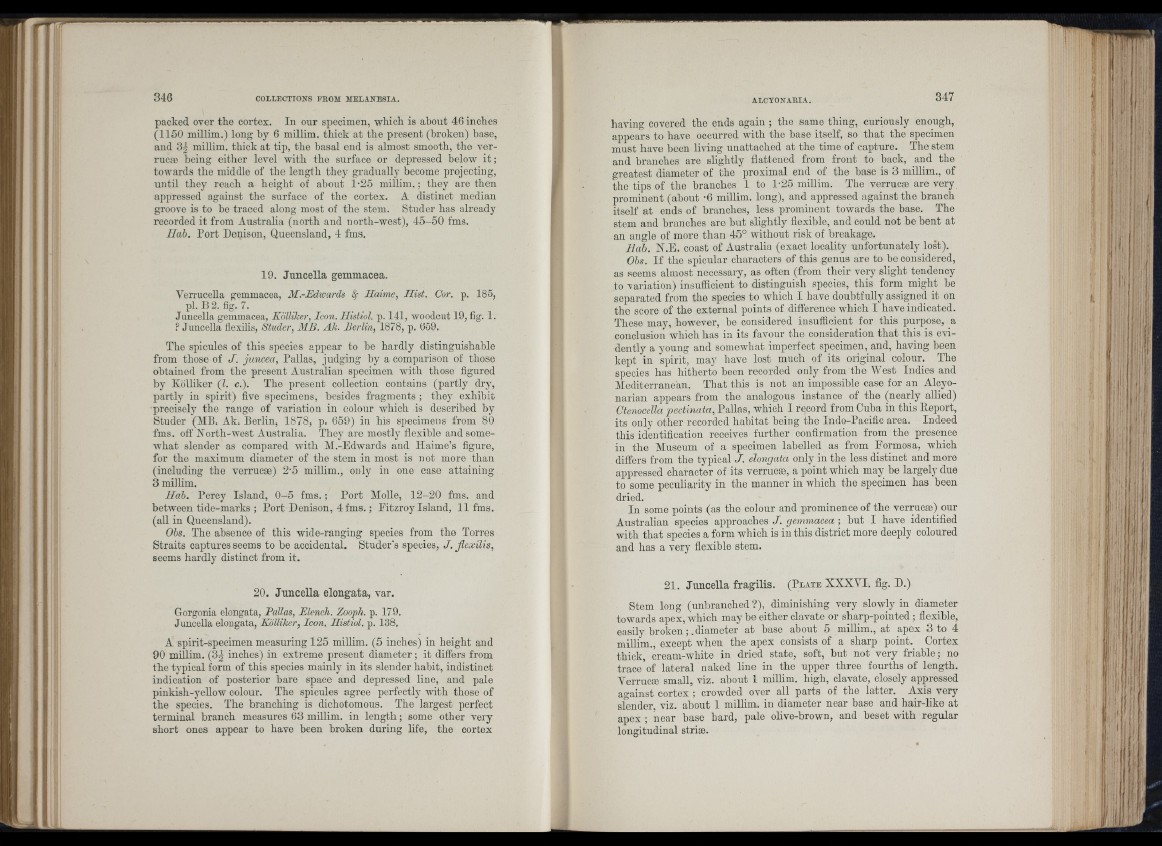
packed over the cortex. In onr specimen, which is about 46 inches
(1150 millim.) long by 6 millim. thick at the present (broken) base,
aud 3g millim. thick at tip, the basal end is almost smooth, the verruca;
being either level with the surface or depressed below i t ;
towards the middle of the length they gradually become projecting,
until they reach a height of about 1-25 millim.; they are then
appressed against the surface of the cortex. A distinct median
groove is to bo traced along most of the stem. Studer has already
recorded it from Australia (north and north-west), 45-50 fms.
Hah. Port Denison, Queensland, 4 fms.
19. Juncella gemmacea.
Verrucella gemmacea, M.-Edivards S; Haime, Hist. Cor. p. 185,
pi. B 2. fig. 7.
Juncella gemmacea, Kolliker, Icon. Histiol. p. 141, woodcut 19, fig. 1.
? Juncella flexilis, Studer, AIB. Ak. Berlin, 1878, p. 659.
Tho spicules of this species appear to be hardly distinguishable
from those of J . juncea, Pallas, judging by a comparison of those
ohtained from the present Australian specimen with those figured
by Kolliker (I. c.). The present collection contains (partly dry,
partly in spirit) five specimens, besides fragments ; they exhibit
precisely the range of variation in colour which is described by
Studer (MB. Ak. Berlin, 1878, p. 659) in his specimens from 80
fms. off North-west Australia. They are mostly flexible and somewhat
sleuder as compared with M.-Edwards and Haime’s figure,
for the maximum diameter of the stem in most is not more than
(including the verrucæ) 2-5 millim., only in one case attaining
3 millim.
Hab. Percy Island, 0-5 fms. ; Port Molle, 12-20 fms. and
between tide-marks ; Port Denison, 4 fms. ; Eitzroy Island, 11 fms.
(all in Queensland).
Obs. The absence of this wide-ranging species from the Torres
Straits captures seems to be accidental. Studers species, J. flexilis,
seems hardly distinct from it.
20. Juncella elongata, var.
Gorgonia elongata, Balias, Elench. Zooph. p. 179.
Juncella elongata, Kolliker, Icon. Histiol. p. 138.
A spirit-specimen measuring 125 millim. (5 inches) in height and
90 millim. ( 3 | inches) in extreme present diameter ; it differs from
the typical form of this species mainly in its slender habit, indistinct
indication of posterior bare space and depressed line, and pale
pinkish-yeUow colour. The spicules agree perfectly with those of
the species. The branching is dichotomous. The largest perfect
terminal branch measures 63 millim. in length ; some other very
short ones appear to have been broken during life, the cortex
having covered the ends again ; the same thing, curiously enough,
appears to have occurred with the base itself, so th at the specimen
must have been living unattached at the time of capture. The stem
and branches are slightly fiattened from front to back, and the
greatest diameter of the proximal end of the base is 3 millim., of
the tips of the branches 1 to 1-25 millim. The verrucæ are very
prominent (about -6 millim. long), and appressed against the branch
itself at ends of branches, less prominent towards the base. The
stem and branches are but slightly flexible, and could not he bent at
an angle of more than 45° without risk of breakage.
Hah. N.E. coast of Australia (exact locality unfortunately lost).
Ohs. I f the sxncular characters of this genus are to be considered,
as seems almost necessary, as often (from their very slight tendency
to variation) insufficient to distinguish species, this forna might he
separated from the species to which I have doubtfully assigned it on
tho score of the external points of difference which I have indicated.
These may, however, be considered insufficient for this purpose, a
conclusion which has in its favour the consideration th at this is evidently
a young and somewhat imperfect specimen, and, having been
kept in sxfirit, may have lost much of its original colour. The
species has hitherto been recorded only from the West Indies and
Mediterranean. That this is not an impossible case for an Alcyonarian
appears from the analogous instance of the (nearly allied)
Ctenocella pectinata, Pallas, which I record from Cuba in this Report,
its only other recorded habitat being the Indo-Pacific area. Indeed
this identification receives further confirmation from the presence
in the Museum of a specimen labelled as from Formosa, which
differs from the typical J. elongata only in the less distinct and more
apjiressed character of its verrucæ, a point which may be largely due
to some peculiarity in the manner in which the specimen has been
dried.
In some points (as the colour and prominence of the verrucæ) our
Australian species approaches J . gemmacea ; but I have identified
with th at species a form which is iu this district more deeply coloured
and has a very flexible stem.
21. Juncella fragilis. ( P l a t e XXXAM. fig. D.)
Stem long (unhranched ?), diminishing very slowly in diameter
towards apex, which may he either clavate or sharp-pointed ; flexible,
easily broken;,diameter a t base about 5 millim., at apex 3 to 4
millim., except when the apex consists of a sharp point. Cortex
thick, cream-white in dried state, soft, hut not very friable; no
trace’of lateral naked line in the upper three fourths of length.
A^errucæ small, viz. about 1 millim. high, clavate, closely appressed
against cortex ; crowded over all parts of the latter. Axis very
slender, viz. about 1 millim. in diameter near base and hair-like at
apex ; near base hard, pale olive-brown, and beset with regular
longitudinal striæ.
ll
i J il